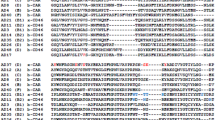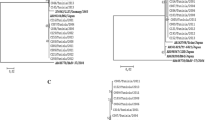Abstract
Purpose
To characterize the virological features of adenovirus type 54 (Ad54) causing nationwide outbreak of severe epidemic keratoconjunctivitis (EKC) in Japan, we comparatively analysed the viral propagation phenotype of Ad54 and other Ads: type 37 (Ad37), 64 (Ad64), and 5 (Ad5), in A549 cells quantitatively.
Study design
Laboratory investigation.
Methods
We compared the growth rate of Ads using copy numbers and cytopathic effect observation during propagation in A549 cell lines. Expressions of mRNA of E1 gene were also calculated and compared. Phylogenetic analysis of the region, including putative promoter of E1 gene and E1 open reading frame (ORF), were performed.
Results
Increases in viral loads, growth rate, and viral propagation were slower for Ad54 than for other Ads. The expression level of the E1 gene per infected cell was lower for Ad54 than for other Ad types on post-infection day 1. Phylogenetic analysis of the E1 gene putative promoter and ORF revealed Ad54 was the closest to Ad type 8.
Conclusion
The propagation of Ad54 in A549 is slow compared with Ad37, Ad64 and Ad5. This slow propagation could have been caused by slow genomic replication resulting from delayed viral entry or E1 transcription initiation. The EKC caused by Ad54 needs more attention because the slow propagation of Ad54 may contribute to prolonged disease duration.





Similar content being viewed by others
References
White DO, Fenner FJ. Adenoviridae. In: Medical virology. 4th ed. San Diego: Academic Press; 1994. pp. 306–16.
Robinson CM, Singh G, Lee JY, Dehghan S, Rajaiya J, Liu EB, et al. Molecular evolution of human adenoviruses. Sci Rep. 2013;3:1812.
Lee CS, Lee AY, Akileswaran L, Stroman D, Najafi-Tago K, Kleiboeker S, et al. Determinants of outcomes of adenoviral keratoconjunctivitis. Ophthalmology. 2018;125:1344–53.
Walsh MP, Chintakuntlawar A, Robinson CM, Madisch I, Harrach B, Hudson NR, et al. Evidence of molecular evolution driven by recombination events influencing tropism in a novel human adenovirus that causes epidemic keratoconjunctivitis. PLoS One. 2009;4:e5635.
Hashimoto S, Gonzalez G, Harada S, Oosako H, Hanaoka N, Hinokuma R, et al. Recombinant type human mastadenovirus D85 associated with epidemic keratoconjunctivitis since 2015 in Japan. J Med Virol. 2018;90:881–9.
Espínola EE, Barrios JC, Russomando G, Mirazo S, Arbiza J. Computational analysis of a species D human adenovirus provides evidence of a novel virus. J Gen Virol. 2017;98:2810–20.
Kaján GL, Kajon AE, Pinto AC, Bartha D, Arnberg N. The complete genome sequence of human adenovirus 84, a highly recombinant new human mastadenovirus D type with a unique fiber gene. Virus Res. 2017;242:79–84.
Ishiko H, Shimada Y, Konno T, Hayashi A, Ohguchi T, Tagawa Y, et al. Novel human adenovirus causing nosocomial epidemic keratoconjunctivitis. J Clin Microbiol. 2008;46:2002–8.
Balasopoulou A, Κokkinos P, Pagoulatos D, Plotas P, Makri OE, Georgakopoulos CD, et al. Α molecular epidemiological analysis of adenoviruses from excess conjunctivitis cases. BMC Ophthalmol. 2017;17:51.
Fujimoto T, Matsushima Y, Shimizu H, Ishimaru Y, Kano A, Nakajima E, et al. A molecular epidemiologic study of human adenovirus type 8 isolates causing epidemic keratoconjunctivitis in Kawasaki City, Japan in 2011. Jpn J Infect Dis. 2012;65:260–3.
Uemura T, Migita H, Ueno T, Tsukahara-Kawamura T, Saeki Y, Fujimoto T, et al. Clinical and virological analysis of epidemic keratoconjunctivitis caused by adenovirus type 54 in a regional ophthalmic clinic in Kyushu. Jpn Clin Ophthalmol. 2018;12:511–7.
Report IAS. Infectious disease surveillance center. Jpn IASR. 2008;29:346–7 (in Japanese).
Nakamura N, Hirano E, Kowada K, Ishiguro F, Yamagishi Z, Adhikary AK, et al. Surveillance of adenovirus D in patients with epidemic keratoconjunctivitis from Fukui prefecture, Japan, 1995–2010. J Med Virol. 2012;84:81–6.
Kaneko H, Suzutani T, Aoki K, Kitaichi N, Ishida S, Ishiko H, et al. Epidemiological and virological features of epidemic keratoconjunctivitis due to new human adenovirus type 54 in Japan. Br J Ophthalmol. 2011;95:32–6.
Fujimoto T, Hanaoka N, Konagaya M, Kobayashi M, Nakagawa H, Hatano H, et al. Evaluation of a silver-amplified immunochromatography kit for adenoviral conjunctivitis. J Med Virology. 2019;91:1030–5.
Zhou X, Robinson CM, Rajaiya J, Dehghan S, Seto D, Jones MS, et al. Analysis of human adenovirus type 19 associated with epidemic keratoconjunctivitis and its reclassification as adenovirus type 64. Invest Ophthalmol Vis Sci. 2012;53:2804–11.
Lorenz RJ, Bogel K. Methods of calculation: the Spearman–Karber method. WHO Monogr Ser. 1973;23:321–9.
Atabani SF, Smith C, Atkinson C, Aldridge RW, Rodriguez-Peralvarez M, Rolando N, et al. Cytomegalovirus replication kinetics in solid organ transplant recipients managed by preemptive therapy. Am J Transplant. 2012;12:2457–64.
Kimura M. A simple method for estimating evolutionary rates of base substitutions through comparative studies of nucleotide sequences. J Mol Evol. 1980;16:111–20.
Yamane S, Lee AW, Hanaoka N, Gonzalez G, Kaneko H, Ishida S, et al. Identification of contamination in the American Type Culture Collection stock of human adenovirus type 8 by whole-genome sequencing. J Virol. 2013;87:1285–6.
Wigand R. Pitfalls in the identification of adenoviruses. J Virol Methods. 1987;16:161–9.
Guo DF, Shinagawa M, Aoki K, Sawada H, Itakura S, Sato G. Genome typing of adenovirus strains isolated from conjunctivitis in Japan, Australia, and the Philippines. Microbiol Immunol. 1988;32:1107–18.
Adhikary AK, Ushijima H, Fujimoto T. Human adenovirus type 8 genome typing. J Med Microbiol. 2012;61:1491–503.
Enomoto M, Fujimoto T, Konagaya M, Hanaoka N, Chikahira M, Taniguchi K, et al. Cultivation for 21 days should be considered to isolate respiratory adenoviruses from samples containing small numbers of adenoviral genomes. Jpn J Infect Dis. 2010;63:338–41.
Akiyoshi K, Suga T, Fukui K, Taniguchi K, Okabe N, Fujimoto T. Outbreak of epidemic keratoconjunctivitis caused by adenovirus type 54 in a nursery school in Kobe City, Japan in 2008. Jpn J Infect Dis. 2011;64:353–4.
Badr KR, Parente-Rocha JA, Baeza LC, Ficcadori FS, Souza M, Soares CM, et al. Quantitative proteomic analysis of A549 cells infected with human adenovirus Type 2. J Med Virol. 2019;91:1239–49.
Yin J, Redovich J. Kinetic modeling of virus growth in cells. Microbiol Mol Biol Rev. 2018;82:e00066–e117.
Kaneko H, Aoki K, Ohno S, Ishiko H, Fujimoto T, Kikuchi M, et al. Complete genome analysis of a novel intertypic recombinant human adenovirus causing epidemic keratoconjunctivitis in Japan. J Clin Microbiol. 2011;49:484–90.
Gonzalez G, Yawata N, Aoki K, Kitaichi N. Challenges in management of epidemic keratoconjunctivitis with emerging recombinant human adenoviruses. J Clin Virol. 2019;112:1–9.
Hierholzer JC. Adenoviruses. In: Lennette EH, et al., editors. Diagnostic procedures for viral, rickettsial and chlamydial infections. 7th ed. Washington, DC: American Public Health Association; 1995. p. 169–188.
Udeh BL, Schneider JE, Ohsfeldt RL. Cost effectiveness of a point-of-care test for adenoviral conjunctivitis. Am J Med Sci. 2008;336:254–64.
Piednoir E, Bureau-Chalot F, Merle C, Gotzamanis A, Wuibout J, Bajolet O. Direct costs associated with a nosocomial outbreak of adenoviral conjunctivitis infection in a long-term care institution. Am J Infect Control. 2002;30:407–10.
Acknowledgements
The authors would like to thank Enago (www.enago.jp) for the English language review. This study was partly supported by a Ministry of Health, Labor and Welfare Grant-in-Aid for Scientific Research (10110713).
Author information
Authors and Affiliations
Corresponding author
Ethics declarations
Conflicts of interest
T. Tsukahara-Kawamura, None; N. Hanaoka, None; M. Konagaya, None; E. Uchio, None; T. Fujimoto, None.
Additional information
Publisher's Note
Springer Nature remains neutral with regard to jurisdictional claims in published maps and institutional affiliations.
Corresponding Author: Eiichi Uchio
Electronic supplementary material
Below is the link to the electronic supplementary material.
About this article
Cite this article
Tsukahara-Kawamura, T., Hanaoka, N., Konagaya, M. et al. Characteristic of slow growth in cell culture of adenovirus type 54 causing nationwide outbreak epidemic keratoconjunctivitis in Japan. Jpn J Ophthalmol 64, 312–320 (2020). https://doi.org/10.1007/s10384-020-00727-2
Received:
Accepted:
Published:
Issue Date:
DOI: https://doi.org/10.1007/s10384-020-00727-2




